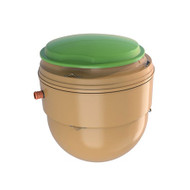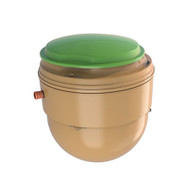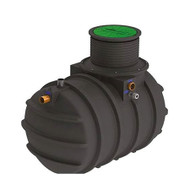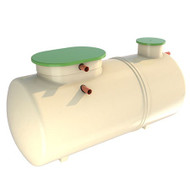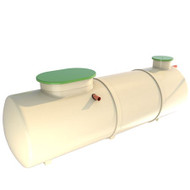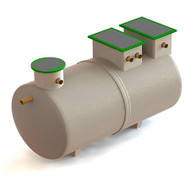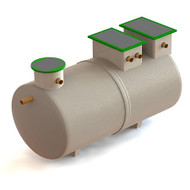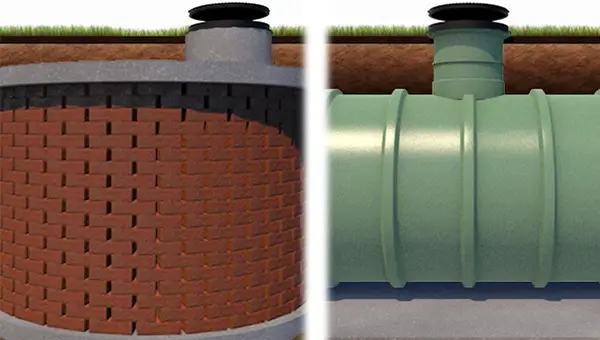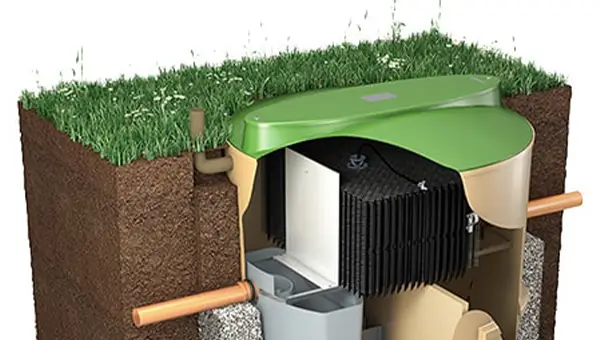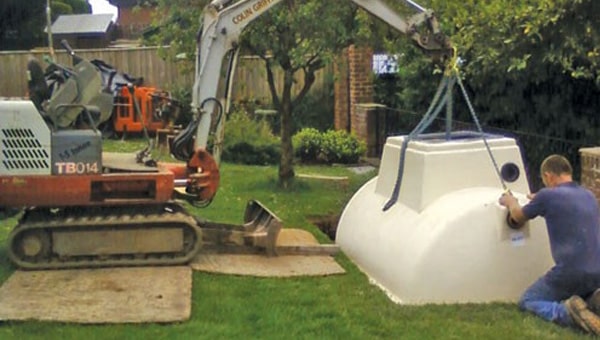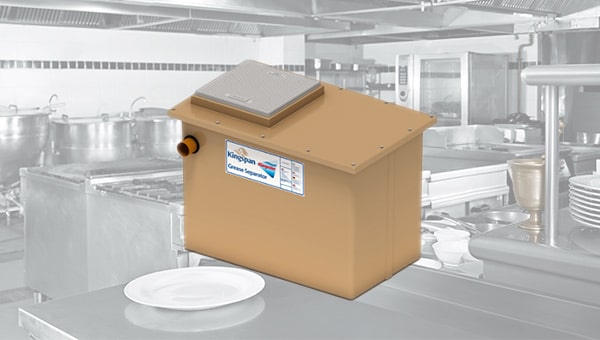What is the best sewage treatment plant seems a simple question... surely there is a simple answer? Well, here's some good news and some bad news — it isn’t a simple question at all, as there are many different aspects and considerations to take into account when choosing the best sewage treatment plant for you.
The good news, however, is that we are here to help guide you through everything you need to know. We're going to take a look at four key characteristics that might influence your decision and explain why they are important. These are:
- Effluent quality
- Operation/maintenance ease & cost
- Installation ease & cost
- Aesthetic appearance
For those that just want to get an idea of which sewage treatment plant is the best for certain scenarios, we'll start with a quick guide.
| Single House | ||
|---|---|---|
| Up to 4 bedrooms | Up to 7 bedrooms | |
| Cleanest Effluent | 6-person Klargester BioDisc BA | 9-person Klargester BioDisc BA-X |
| Cheapest Operation & Maintenance | 6-person Klargester BioDisc BA | 9-person Klargester BioDisc BA-X |
| Easiest to Install | 6-person Klargester BioFicient 1 | 10-person Klargester BioFicient 3 |
| Best Aesthetics | 6-person Clearwater Delta 1 | 12-person Clearwater Delta 2 |
| Budget Option | 6-person Clearwater E6 | 12-person Clearwater E12 |
| Multiple Houses | ||
|---|---|---|
| 2 Houses Up to 8 bedrooms | 3 Houses Up to 12 bedrooms | |
| Cleanest Effluent | 12-person Klargester BioDisc BB | 18-person Klargester BioDisc BC |
| Cheapest Operation & Maintenance | 12-person Klargester BioDisc BB | 18-person Klargester BioDisc BC |
| Easiest to Install | 10-person Klargester BioFicient 3 | 15-person Klargester BioFicient 4 |
| Best Aesthetics | 12-person Clearwater Delta 2 | 18-person Clearwater Delta 3 |
| Budget Option | 12-person Clearwater E12 | 18-person Clearwater E18 |
Please note: We have only compared products from the Klargester and Clearwater sewage treatment plant ranges, however the decision making factors we discuss here are suitable for comparing all brands of sewage treatment plants. Find out more on how to correctly size the sewage treatment plant your property needs, or contact JDP for assistance.
Okay, so there’s our recommendations based on the four key characteristics we identified. We also added a "budget option" for situations when the initial upfront cost of the product may outweigh all other considerations. But how and why did we come to make these recommendations? Let's dive in to explain in more detail.
Effluent Quality
The effluent quality of a sewage treatment plant is one of its most important factors especially if it is to discharge into a watercourse (permission from relevant environment agencies is required). It must have been treated to a sufficient standard so as to prevent any damage to the environment or risk to human health. For this reason, all sewage treatment plants sold in the UK MUST have passed testing under the BS EN 12566-3 standard in order to be deemed legally compliant.
The BS EN 12566-3 standard states that the effluent produced by the sewage treatment plant must conform to following maximum tolerances for quality of discharge:
- BOD5 = no greater than 20 mg / litre Biochemical Oxygen Demand; the amount of oxygen consumed by bacteria and other micro-organisms to degrade the water contents aerobically. The higher the demand, the more oxygen will be consumed from the water, and too high a demand is dangerous and can render the environment unsuitable for aquatic life. "BOD5" is the measure of a sample through a period of 5 days at a temperature of 20°C.
- SS = no greater than 30 mg / litre Suspended solids are tiny floating particles in the effluent that don't settle easily, and don't drop to the bottom of the tank for desludging, and could continue throughout the watercourse. This is another important indicator of water quality, as these particles can carry pollutants and pathogens. The higher the volume of suspended solids, the higher the pollutant load that is likely to be carried through the water.
- NH4-N = no greater than 20 mg / litre An inorganic nitrogen compound named ammonium which arises from the biological degradation of organic nitrogen compounds. Ammonium can be converted into nitrate by adding oxygen (nitrification) which, in an aquatic environment, causes high oxygen consumption. In addition, the ammonia present in the compound can promote the growth of algae. Neither of these things are a desirable result of effluent discharge.
All sewage treatment plants sold in the UK will produce at least this quality of effluent, meaning they will be acceptable for use under national environment agency standards. However, minimum requirements can vary depending on where the outlet is discharging to, and some sewage treatment plant’s only test to the limit of regulated tolerances (ask the supplier/manufacturer for the tank’s EN 12566-3 certificate to check the performance results yourself).
If protecting the environment is important to you, you’ll want a sewage treatment plant that performs far better than the minimum requirements. You’ll want these figures to be as low as possible to ensure that the effluent you discharge is made as environmentally safe as possible.
From the range of treatment plants in this article the Klargester BioDisc range is best for effluent quality as it can, in normal domestic situations, produce effluent qualities of 8mg/l BOD, 13mg/l SS and 4mg/l ammonium. This puts its effluent quality well under the maximum tolerances, and makes it the best option producing the cleanest discharge.
Operation/Maintenance Ease & Cost
One of the biggest headaches you face in having an off-mains sewage system is the extra costs involved in running and maintaining them. Because they are considered private systems all responsibility for them falls upon the property owner. If not properly cared for your sewage treatment plant could land you in all kinds of legal and financial difficulties... welcome to sewage treatment plant club!
This is why it is important to really do your research and understand exactly what the needs and limitations of your system will be, as this will better enable you to forecast the costs involved in running it.
How much does it cost to run a sewage treatment plant?
The energy running cost of a 6-person Klargester BioDisc BA at 682.55 kWh/year, with a UK average kWh unit price of £0.14, means this treatment plant would cost £96 per year to operate (at the time of writing this in 2020, at least). You must also consider servicing, regular desludging and maintenance costs.
Energy consumption
The first rule of sewage treatment plant club is, well, no one really wants to talk about sewage treatment plant club. But the second rule of sewage treatment plant club is all about power.
The vast majority of all sewage treatment plants require power to work and that means having an electricity supply. Just like any other electrical appliance you plug in, your sewage treatment plant is going to increase your electricity usage and therefore increase your bill. The good news is that most sewage treatment plants are designed to be as economical as possible so the cost per year to you should be fairly low.
Most manufacturers will display the power consumption of their sewage treatment plants in kWh per year, however, you may find that some give it in kWh per person per year — which means you’ll need to multiply the figure by the number of people the unit will service. It’s always worth double checking the figures to make sure you don’t get a nasty surprise further down the road. It’s important to remember that your sewage treatment plant will likely be running 24 hours a day for 365 days a year and may need to service different volumes of people throughout that time. For that reason, even if there are only 3 people in a 6 person house, it’s always better to calculate for the recommended number of persons the unit is designed for and not the actual number of people living in the property.
Servicing & maintenance
In order to ensure that your sewage treatment plant remains in good working condition and continues to comply with national environment agency standards, it will need to be regularly serviced — most often 6 monthly or annually — by a qualified professional. Most manufactures will offer their own servicing contracts when you buy a tank and it is recommended that you take these out. It is worth the extra cost for both peace of mind and to know that you will have a full certified servicing history for your sewage treatment plant, which is becoming more frequently requested now by solicitors if you come to sell your house.
Desludging costs
Aside from the servicing you will also need to have the tank emptied regularly by a registered carrier to remove the sludge that forms when the solid material is separated out of the effluent and settles at the bottom of the tank. This builds up over time and can impact the efficiency of your sewage treatment plant if left too long. Recommended desludging frequency varies from 3 months to 3 years depending on the manufacturer and model. However, we would recommend that you should be having this done at least once a year, just to be on the safe side. When it comes to sewage treatment, you never want to test the limits of a product's capabilities.
Typical costs for both annual servicing and desludging are between £100-£200 each, but this can vary widely depending on the type of plan and service provider. If running costs are your main concern, you’ll definitely want to look for a sewage treatment plant that requires low maintenance, less frequent desludging as well as a high energy efficiency rating. But remember, these are things you MUST have if you own a sewage treatment plant, there is no getting away from that. So make sure you incorporate this maintenance expense into your calculations.
Noise & smell
Due to the required oxygenation of the water, as part of the sewage treatment process, generated through the use of an air blower, there can often be an audible vibration or buzzing sound to many sewage treatment plant’s. If you feel this would be a problem for you, look for models that actively claim to be “virtually silent”. Despite what they contain, a well maintained sewage treatment plant’s should not produce a noticeable smell. However, tanks with lots of internal working parts are more prone to maintenance issues that could potentially cause foul odours to appear until fixed. Look for models that promote low maintenance needs and have a good warranty on internal parts. Ask the manufacturer for official testing results, warranty on parts and service packages for peace of mind.
Alarm system
All sewage treatment plants must have an alarm according to building regulations. However, the type of alarm can vary from wired control panels to wireless receivers. Perhaps not a high priority choice, but worth considering if you have a preference over where you’d like your alarm to be located. Ask the supplier/manufacturer for specific details.
Tank warranty
If a sewage treatment plant tank cracks or leaks, it’s not difficult to imagine the mess you will be in...and a costly one at that. Generally speaking, a tank will not crack or bend within the first 12 months of install. If they are going to fail, it will be once the ground has fully settled, which could take a few years. The longer the warranty, the more confidence the manufacturer has in the quality of their product, and the more peace of mind you will have. We’d recommend looking for a minimum warranty of at least 5 years. Contact supplier/manufacturer if the warranty period is not stated in the product description.
Installation Ease & Cost
For those at the back — installing a sewage treatment plant is not easy and should always be carried out by a suitably trained and qualified professional. There are so many factors to consider from the depth of the bedrock and the height of the water table, to the slope of the land, intended discharge area, building regulations, environmental permits, work vehicle access and the height of the discharge point, just to name a few. For more detailed information about this, check out our sewage treatment plant installation guide.
What makes a sewage treatment plant easier to install than its counterparts?
Generally speaking there tends to be two types of sewage treatment plants; spherical and shallow dig/low profile. The latter of these two types are longer than they are deep, meaning that they require a shallower hole dug for installation. This can offer a saving of both time and money and also enable properties in higher water table areas to still install a sewage treatment plant, however, it is worth remembering that they will take up more horizontal space under the ground which could be an issue for minimum distance restrictions. Make sure you take this into account during the planning stages of your system.
The Clearwater Delta range of sewage treatment plants are one such low profile option, requiring shallower excavation that is suitable for varying invert levels. They are also fully CE-marked, compliant with BS EN 12566 Part 3 and are one of the more budget friendly models available. They don’t produce as high quality effluent as the Klargester BioDisc, nor are they as energy efficient, but if ease of install is your prime concern in choosing your sewage treatment plant the Clearwater Delta range is a good choice.
Other factors that can have an effect on the scale and cost of the installation include:
- Tank material — sewage treatment plants can be made out of a number of different materials, all with their own plus and minus points.
- GRP — a fairly common choice, but care should be taken during transportation and installation as these tanks are easily damaged.
- HDPE — incredibly strong, but can bend slightly over time without reinforcement.
- PP — a low cost material that is equally as strong, but a minimum thickness of 8mm should be ensured.
- Concrete — an excellent material for strength but has become less common now due to much higher install costs and maintenance difficulties.
- Excavation size — having the required space is important. The larger the tank, the larger the excavation and the greater the cost.
- Excavation depth — a deep dig tank can significantly increase the cost of installation but will generally take up less horizontal space under the property. A shallow dig tank can reduce the cost and be more suitable in higher water table areas, but will also take up more horizontal space - which could be an issue for minimum distance restrictions.
- Siting the tank — will the selected tank fit within your planned area of install while remaining compliant with current legislation?
- Pipe invert levels — this is important to know if you are retrofitting a new tank and plan to use existing inlet and outlet pipework. Depending on your site conditions and restrictions this could narrow down your choice of sewage treatment plant.
For all installation related factors, you will need to check the relevant installation guides and technical drawings (provided by supplier/manufacturer) and/or consult the building regulations.
Klargester BioFicient
Aesthetic Appearance
While perhaps not the highest point of consideration for a tank that goes under the ground there will always be some visual indication of it being there. If you like to keep an immaculately landscaped garden, for example, the following aspects could prove important to your decision.
- Kiosk type — this varies between sewage treatment plants and can be either built into the tank or located in a separate housing to be located above ground. Built-in ones are unobtrusive but can cause maintenance challenges. Above ground housings are easier to maintain but can sometimes look unsightly.
- Cover size & type — covers also vary largely between sewage treatment plants, from large, visually appealing lumps in your garden, to small, unobtrusive discs that blend in with the grass. They can also be made from different materials, often influenced by the type of loading they will need to withstand
None of the sewage treatment plants in either the Klargester or Clearwater ranges have any external housing or kiosks to clutter up your garden (though the BioDisc does have a control panel). The systems are built into the tanks and designed to be hassle free when it comes to maintenance.
The Clearwater Delta sewage treatment plants, however, only require a small and unobtrusive cover. So, if you want to see as little visual evidence of your sewage treatment plan as possible, a Clearwater Delta is a good choice.
So there we have it — these are the best Klargester and Clearwater sewage treatment plants based on effluent quality, operation/maintenance east and cost, installation ease and cost and how pretty they'll look once they're in the ground.
Figuring out what the best sewage treatment plant is a choice of these four criteria and an understanding of your project's requirements, there isn't a one-solution-fits-all answer to the question. Our recommendations here are intended simply to help explain the differences between the various types of sewage treatment plants from Klargester and Clearwater, and should not be taken as a definitive buyers guide.
It is up to you to ensure that the tank you choose is appropriate for the specific ground conditions and in-service loads of your property. In some cases, you may not have the luxury of choice. You may be forced to accept one type of sewage treatment plant based on the results of a site survey that would determine the intended load, space available, or suitability of ground for install and discharge options. It is imperative to seek professional advice in both the planning, purchasing and installation of your sewage treatment system.
Here at JDP our technical team is always on hand to offer free and impartial advice for all of your drainage needs. Contact us today if you have any questions about your current or upcoming projects.


